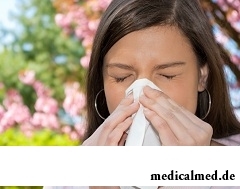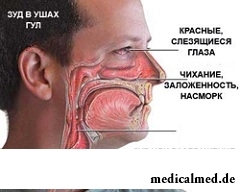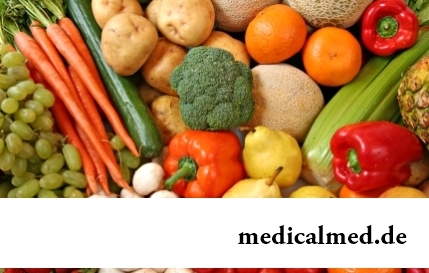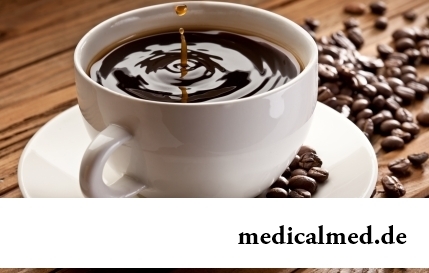





Pollinosis

Hypersensitivity to pollen of trees, bushes and plants provokes development of such disease as a pollinosis or allergic seasonal rinokonjyunktivit. The name "hay fever" is distributed in the people though the disease has no relation to fever, and hay is not a releaser to start a disease.
Distinctive feature of a pollinosis is seasonality. Symptoms of a disease are shown only in a blooming period of certain species of plants from year to year. At a pollinosis there is a damage of mucous membranes of eyes and upper respiratory tracts as a result of sedimentation of pollen in them. Also at this disease impact on a nervous system and internals is made. Quite often there is a cross allergy when at intolerance of some foodstuff there are allergic reactions to pollen of related bushes and trees, or combined at which the pollinosis develops in response to implementation of several types of pollen.
In risk group there are preferential women aged from 25 up to 45 years. At children's age from a pollinosis boys most often suffer. Prevalence of a disease quite considerable. In spite of the fact that the pollinosis does not enter into group of diseases which exert impact on life expectancy, it can significantly reduce quality of life. Especially when the sensitization on dust joins already available allergic diseases like atopic dermatitis or bronchial asthma.
Types of a pollinosis and their symptoms
Very often the pollinosis is taken for ORZ, especially right at the beginning. Signs at these diseases are almost identical each other: dacryagogue, headache, fatigue, weakness, loss of appetite, nose congestion, cold, sneezing and cough. But at the same time nevertheless it is possible to allocate a number of differences on the basis of which it is possible to suspect development of a pollen allergy, i.e. a pollinosis.
Most often the pollinosis is shown in the form of rhinitis and conjunctivitis, atopic dermatitis and seasonal bronchial asthma meet a little less often:

- Seasonal rhinitis is characterized by plentiful watery allocations from a nose which tickling and an itch in a nose, a nose congestion, pristupoobrazny cough join. At children the pollinosis of this look can proceed in combination with noise and ear pain.
- At seasonal conjunctivitis puffiness and reddening of a mucous membrane of eyes, dacryagogue, feeling of an itch and "sand" is noted. As a rule, at true seasonal conjunctivitis a discharge from eyes of mucous character, purulent discharges appear only in case of entering of an infection.
- atopic dermatitis at a pollinosis is shown by rashes on open body parts. The disease proceeds various degrees of severity, from an insignificant small tortoiseshell to the strongest Quincke's disease of Quincke.
- attacks of suffocation are characteristic of seasonal bronchial asthma.
At defeats of a nervous system and internals the pollinosis can be followed by such diseases as a vulvitis, epileptopodobny attacks, arakhnoentsefalit.
All signs of a pollinosis disappear as plants, bushes and trees fade. In total the disease proceeds within 4-6 weeks, in hard cases – all spring - the summer period.
Treatment of a pollinosis
At a pollinosis treatment is directed to decrease in a sensitization of an organism. Antihistamines are for this purpose used, in case of their inefficiency or at a heavy current glucocorticosteroids are appointed. Means are at the same time applied to elimination of symptoms of a disease, both a local, and general meaning. It is not recommended to use for treatment at children of a pollinosis drugs which part leaves, kidneys, flowers, bark and roots of various plants, bushes and trees are.
During the acute period at a pollinosis it is necessary to keep to a diet strictly. Without fail honey and the cross reacting products have to be excluded from a diet. For example, at an allergy to cereals grain porridges, bakery products, pasta are as far as possible excluded. It is impossible to eat apples, a kiwi, nuts, plums, potatoes and some other products at a sensitization to pollen of an alder, a birch, apple-trees. Fruits of a citrus are not used at reaction to pollen of weeds.
In hard cases moving to other climatic zone is shown.
Prevention of a pollinosis
Prevention of a pollinosis has to be complex, including eliminative actions, a specific immunotherapy and observance of a diet.
Eliminative actions at tendency to a pollinosis consist in performance of a number of requirements for minimizing an adverse effect of pollen on an organism. For this purpose it is necessary to avoid visit of squares, parks and to that similar objects. The amount of the pollen coming to the room can be limited by means of a zaveshivaniye of open window leaves and windows to a gauze.
For prevention of development of atopic dermatitis it is desirable to put on clothes with long sleeves and trouser-legs. It is recommended to remove from the room bouquets from flowers and room bloomers.
One of the most effective methods in achievement of remission at a pollinosis is carrying out a specific immunotherapy. It consists in introduction to the patient's organism out of a phase of an aggravation of small doses of causal and significant allergens. With each injection the amount of the entered allergen increases, as a result of manipulations hypersensitivity decreases. Medical procedures are carried out only in specialized offices under observation of the specialist.
In a stage of remission it is possible to eat all products, but at the same time not to abuse them.
The most high temperature of a body was recorded at Uilli Jones (USA) who came to hospital with a temperature of 46,5 °C.

Obesity is called by a disease of 21 centuries, for the last 100 years by the number of the people suffering from excess body weight, considerably increased...
Section: Articles about health
There is a lot of fans of beer in our country. Statistically, on each average Russian (including women and children) in a year about 60 liters of this drink are consumed. It is not a lot of, as in the Czech Republic or Germany, but figure all the same impressive. Radova...
Section: Articles about health
You are office worker, the driver, the fan of winter sports or do not think of life without bicycle? You lead a slow-moving life and you move on the city only on the car? You have no constant partner and you do not love the protected sex? Attention! You unambiguously are a potential target for prostatitis. It is not necessary to panic, it is necessary to work....
Section: Articles about health
Musicotherapy – a treatment method which caused and causes a set of a controversy concerning its efficiency. However the facts are relentless:...
Section: Articles about health
EKO, or extracorporal fertilization - a method of treatment of infertility which became the reason of a set of broken-down copies in due time accused the people working on its creation neither more nor less of rivalry good luck. Already very few people deny the rights...
Section: Articles about health
Many of us, probably, noticed more than once that from intellectual loadings at some point the brain as though "overheats" and "assimilation" of information is strongly slowed down. Especially this problem urgent for persons of age becomes more senior than fifty years. "Already badly I think", "the head will burst now", "memory as if is disconnected" - here that wants to be told at the time of information overload....
Section: Articles about health
Is told about advantage of domestic animals for development of the child much. But many parents nevertheless do not hurry to bring pets as about...
Section: Articles about health
Childbirth is the most important event in life of each woman. We are women we give birth to the new little man on this light. Now the tendency to that was outlined, as men want to participate in labor too. But there is a question and whether it is worth allowing the husband...
Section: Articles about health
Household skills which to us so diligently imparted in the childhood it appears, not always bring only benefit. According to results of the last researches, some habits which for a long time were considered useful and even necessary can become the reason of serious indispositions. Here only seven the most widespread of them....
Section: Articles about health
The majority of gynecologic diseases prove three main signs, each of which speaks about need to the visa...
Section: Articles about health
What woman does not dream of a beautiful and thick hair? While physicians developed difficult schemes on hair transplant, in the industry of hairdresser's art a few years ago there was a sensation – methods of hair extension appeared. It would seem, dreams came true...
Section: Articles about health
The endocrine system carries out extremely important role in a human body, practically all processes of life activity are regulated by it. Closed glands (hemadens) produce special biologically active agents – hormones which then get to a blood channel and are transferred to bodies addressees, or as they are called still, to target organs. Frustration of this mechanism are fraught with development of serious chronic pathologies....
Section: Articles about health
The naturopathy sometimes moves as the new direction of medicine, something like fashionable hobby, and there is nothing farther from the truth....
Section: Articles about health
The technique of acupuncture (acupuncture) is used in the medical purposes more than three and a half millennia. It is eurysynusic and recognized as official medicine in the majority of the developed countries of the world. Influence by fine needles on so-called points...
Section: Articles about health
The depression not without reason is considered one their main troubles of our century: for scientific and technical progress, acceleration of rate of life and a surplus of information of people it is forced to pay with stresses, negative emotions and weakening of protective forces of an organism. As a result widely the states which are characterized by the increased uneasiness, falling of interest in life, spiritual and physical discomfort extend....
Section: Articles about health
Iodine - one of thirty most important microelements in our organism. The main role of iodine consists in synthesis thyroid гормо...
Section: Articles about health
(Xerostomia) many people consider feeling of a xerostomia small and easily removable inconvenience. This delusion: the symptom can demonstrate existence of serious diseases. It is worth to remember also that saliva performs important functions...
Section: Articles about health
Tick-borne encephalitis – one of the most dangerous viral diseases which causative agents transfer and is given to people by ixodic mites. These are the small blood-sicking insects living in the considerable territory of our country. The person bitten by a tick can catch also erlikhiozy, bartonnelezy, babeziozy, mycoplasmosis and Lyme's disease. As well as encephalitis, these illnesses affect the central nervous system, and as specific antiviral therapy does not exist, the forecast very to a neuta...
Section: Articles about health
All are familiar with cold, and practically everyone believes that he has sufficient knowledge and experience that correctly to treat it. N...
Section: Articles about health
The stroke is one of the most widespread diseases of the person, annually in the world about 6 million cases of this pathology are registered. According to medical statistics, strokes occur almost three times more often than myocardial infarctions. Disease otno...
Section: Articles about health
One of the useful properties presented to the person by the nature is ability to feel fear. This ability is designed to signal about approach of a dangerous situation and to help to avoid in advance it to keep life. However if the fear is persuasive and is not reasonable, it can seriously limit possibilities of the person in respect of socialization and self-realization. Such pathological fear is called a phobia....
Section: Articles about health
So, you resolved to lose weight. And now you try to understand what to begin with: from exercise stresses or a diet? And how to make, h...
Section: Slideshow
Color of plants is caused by presence at them of certain chemical compounds. Let's talk about what is meant by various colors of vegetables and fruit and what properties they give them....
Section: Articles about health
Stability of a hormonal background is one of the most important conditions of preservation of health of the woman. At the same time endocrine system – the thin device extremely sensitive to any external influences. Changes of a way of life (for example, a diet), emotional stresses, infectious diseases, reception of some drugs can become the reason of hormonal failure. Besides, work of hemadens has the natural specifics in certain moments of life: on various St...
Section: Articles about health
The state of health of the person in many respects depends on chemical composition of biological liquids of an organism. Specialists consider that з...
Section: Articles about health
Coffee – favourite drink of many. For the last decades it more than once already declared very harmful, extremely useful and even necessary for normal life activity. In spite of the fact that this product became for us usual for a long time, exists much...
Section: Articles about health
The popular expression "run from a heart attack" became the motto of the people supporting active lifestyle. Moreover, run became a peculiar fashionable tendency: sales of racetracks and the accompanying goods for run are at permanently high level. Whether really it is possible for one and all people and it is necessary to run to receive the portion of health, a charge of cheerfulness and good mood?...
Section: Articles about health
